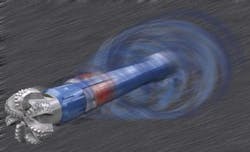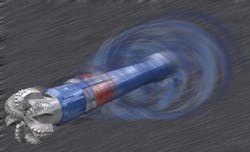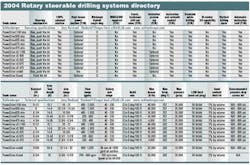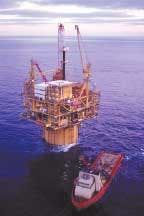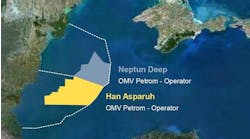Frank Hartley
Drilling/Production Editor
Editor's note:Offshore's directory of rotary steerable drilling equipment and services includes new and updated product specifications and descriptions provided by the participating companies. It is organized alphabetically by company, service line, and associated equipment. Although every effort has been made to include all rotary steerable providers, Offshore does not guarantee that the directory is an exhaustive list of rotary steerable equipment and services. To participate in future rotary steerable system directories, contact Frank Hartley, Drilling/Production Editor, at [email protected].
Click here to view the Directory in pdf.
Rotary steerable systems have been on the market for over five years and have hundreds of successful runs and millions of feet drilled to verify their reliability. The systems have demonstrated that with the proper drilling parameters and bit selection, they can produce accurate results with less downtime and produce a cleaner, more quickly drilled hole and smoother wellbore.
Rotary steerable system manufacturers who elected to be represented in this year's equipment directory described a number of new tools and technology:
Baker Hughes Inteq
Developed jointly by Eni (Agip) and Baker Hughes Inteq, the first-generation AutoTrak Rotary Closed Loop System (RCLS) was introduced in 1997. Since then, over 2,500 jobs have been performed with over 10 million ft of hole drilled. According to Baker Hughes, AutoTrak systems have delivered precise, consistent steerability in formation types ranging from the very weak, unconsolidated formations in deepwater West Africa to the hard rock formations onshore Italy. Well types have varied from >10 km extended reach wells in Asia to complex 3D well paths in the North Sea. The product is now in its third-generation form – a completely new system designed for increased reliability, durability, and capable of integrating advan-ced formation evaluation LWD systems as close to the drill bit as possible.
More than a "rotary steering" system, Baker Hughes describes the AutoTrak RCLS as a fully integrated rotary steerable and advanced LWD system. The system integration reduces bit-to-sensor spacing, reduces the number of BHA components, and shortens the overall BHA length. AutoTrak also incorporates a precise, automated directional control system. This closed-loop deviation control allows precise wellbore placement automatically for consistent, pinpoint target interception, the company says. Combining the short BHA length and precise directional control with advanced geosteering allows maximum reservoir exposure in each well, resulting in increased production at reduced drilling costs. For one offshore Norway field, the operator has attributed over $6 billion of incremental asset value to the unique contributions of the AutoTrak system.
Gyrodata
Gyrodata says its Well-Guide RSS is a fully automated rotary steerable drilling system using point-the-bit technology. The system can kick-off from vertical or in a deviated section and drill a complex directional trajectory through a pre-programmed course with full downhole closed-loop control.
The system consists of a stationary outer collar through which a rotating shaft drives the drill bit. Steering is accomplished by bending the rotating shaft with hydraulic actuators to point-the-bit in the target direction. As a result, it drills a smooth wellbore with no unwanted doglegs and low tortuosity, the company says.
Directional sensors mounted in the tool housing close to the bit provide continuous trajectory updates, and the system can correct automatically for any deviation from the programmed course. In addition, messages can be sent from surface to the tool at any time to make course adjustments or changes. According to the company, key features and characteristics of the Well-Guide RSS include:
- Allows kick-off from vertical or in a deviated section
- Provides high side gravity tool face for work in magnetic environments
- Employs fully automated closed-loop control downhole
- Near-bit directional sensors provide continuous 3D azimuth and inclination updates
- Pre-programmable for multiple trajectories
- Trim control from surface while drilling
- Full thru-bore provides low-pressure loss for unlimited flow rates
- Two full-gauge rotating stabilizers for optimum hole cleaning and unlimited backreaming
- No restrictions on formations, fluid characteristics or bit selection
- Proven field performance and reliability.
Halliburton Sperry-Sun
Using second-generation, point-the-bit technology, Halliburton's Geo-Pilot rotary steerable system enables a full-gauge hole to be drilled, the company says. By answering the "how to steer an extended-gauge bit" question, Halliburton says this system has consistently provided the highest level of hole quality and increased reliability. The centralizing effect of the extended-gauge bit keeps the hole on its true centerline, eliminating borehole rugosity and making all well operations (hole cleaning, tripping, running logging tools, and casing) more efficient. The Geo-Pilot system, from Halliburton's Sperry-Sun and Security DBS product service lines, works by deflecting a drive shaft midway between two bearings, causing it to flex slightly, which is translated across the lower bearing to become bit tilt. The tool is controlled from the surface in real-time while on bottom drilling and is invisible to the drilling operation, eliminating pump cycles or tool communications interruptions for reprogramming. In addition to downhole closed loop control, there are more than 1,400 different steering settings, allowing the Geo-Pilot system to be precisely maneuvered. This combination provides an extremely fast drilling operation with significantly lower non-productive time, the company says. The Geo-Pilot system is said to be the first point-the-bit tool to be widely commercialized and has completed more than 700 runs and drilled more than 1 million ft. With successful jobs completed throughout the world, the Geo-Pilot system has drilled vertical, horizontal, multilateral, extended-reach, and high build rate applications and has consistently out-drilled other technologies.
Noble Downhole Technology
Once a niche-market technology reserved for difficult or complex wells, rotary steerable drilling systems today have become a mainstream service that offers advantages for a number of applications. They offer the ability to drill directionally and continuously without having to stop or slow down to change direction, allowing uninterrupted drilling with continuous weight on the bit, while at the same time providing real-time log data.
According to Noble Downhole Technology, Well Director is a state-of-the-art 3D rotary steerable drilling tool capable of meeting the growing demand for advanced directional drilling technology. The company says the technology provides precise directional drilling control, increased rates of penetration, and a smoother less tortuous well bore. The tool's near-bit sensors make continuous adjustments in the azimuth and inclination headings to accurately steer the well to the desired targets. This enables operators to accurately and efficiently drill long horizontal and directional wells that were previously not cost effective. In addition, the use of this tool as a vertical control tool greatly improves the efficiency of drilling deep vertical wells in heavily faulted formations.
Noble says it has significantly upgraded the tool since its acquisition in 2002, including new high temperature (175° C) sensors and electronics. It can be operated in conjunction with other service companies M/LWD and formation evaluation tools, providing increased flexibility when choosing suppliers.
Pathfinder Energy Services
Pathfinder Energy says its PathMaker 3D Rotary Steerable system is the culmination of five years of research and development. Its primary application is to provide the operator with the technology to steer the wellbore precisely into the targeted reservoir, without interrupting drilling operations. It replaces the conventional "steerable motor" for all on-hore and offshore drilling applications, while providing the operator with a quality wellbore. The PathMaker is compatible with all of PathFinder's formation evaluation services.
Some of the features the company lists are:
- Used in a "point the bit" configuration for improved hole quality
- Push the bit configuration available
- Simple and reliable downhole programming without interrupting the drilling operation
- Continually transmits directional position, which is displayed real-time at the surface
- Can be used as a stand-alone device with any MWD system
- Can effectively steer in hole sizes up to 1 in. over gauge
- Through contact with the borehole wall, the non-rotating stabilizer blades provide a real-time hole calliper measurement
- Compatible with any PathFinder LWD services and BHAs.
Some of the main benefits described are:
- Consistent quality and smooth wellbore
- Increased rate of penetration.
Precision Drilling
Precision Drilling says its Revolution service includes the first 4 3/4-in. slimhole rotary steerable system to use point-the-bit technology. According to Precision, extensive laboratory drilling tests, BHA software modelling, and field experience show point-the-bit mode provides better hole quality, longer bit life, lower bit vibration, and more efficient rock cutting than push-the-bit mode.
Point-the-bit mode uses a pivot stabilizer between the bit and rotary steering tool to orient the drill bit axis with the axis of the hole. This set-up improves wellbore quality by reducing ledging, spiraling, tortuosity, and gauge problems associated with push-the-bit systems, the company says.
Simulation and field experience has been used to optimize BHA designs that achieve efficient face cutting of the bit in point-the-bit mode. These designs help the Revolution slimhole RSS maximize penetration rates and eliminate inefficient side-cutting forces, improving bit life and stability while reducing harmful vibration that can damage other BHA components, such as LWD tools.
Point-the-bit systems ultimately drill a smoother wellbore that is more nearly gauge than push-the-bit systems. A smooth wellbore allows the Revolution RSS to consistently steer the bit to the exact target location, extending well sections and improving reservoir optimization.
The Revolution system's compact design reduces BHA complexity, while placing critical LWD formation evaluation components close to the bit. The result, the company says, is higher than average ROP and fewer doglegs than in wells drilled with conventional drilling motors.
Virtually all rotary steerable systems employ a borehole contacting, or bias, device for providing radial force, the company says, and the orientation and deflection of this device must be measured. The Revolution slimhole RSS uses a new method of measuring orientation and deflection, employing dynamic measurements from sensors rotating with the drive shaft and having no physical connection with the bias unit. This enables the entire annular space to be used for the sleeve positioning hydraulics, the company says.
Rotary Steerable Tools
Rotary Steerable Tools (RST) was incorporated in 1998 and says it is becoming the leading provider of simply constructed, reliable, effective and low cost, directional drilling tools, including a rotary steerable system that improves the practice of directional drilling.
RST says its tool design is simple and low cost. The tool has no practical limitations on flow rate, rotary speed or weight on bit, the company says. Communication to the tool to change tool face heading is made through simple RPM commands. The tool has less than 70 total components and is field serviceable. It is capable of producing a dogleg severity as high as 8°/100 ft, and can also be used to keep wells vertical. The through-bore nature of the tool means valuable pump pressure is available for hole-cleaning, and new technology such as thru-bit-logging is enabled. The simple, low-cost features of the RST tool allows the expansion of the proven technical benefits of rotary steerable systems from current high cost, complex well profiles to lower cost environments and more conventional directional well profiles, the company says.
The tool is an instrumented, near-bit stabilizer, with three main components: a rotating mandrel, an eccentric inner sleeve, and a weighted, non-rotating outer housing. The tool works by controlling the orientation of the eccentric, inner sleeve, which offsets the mandrel and thus the bit, in the desired direction. Rotation of the inner sleeve to change tool face orientation is made by a geared, brush-less DC motor powered by lithium batteries.
Schlumberger
Schlumberger's suite of full-rotation rotary steerable services – the PowerDrive family – delivers leading-edge technology for all directional drilling environments, the company says. The company says the products offer exceptional rates of penetration and efficient hole-cleaning in the most demanding applications – kickoff from vertical, open-hole sidetracks, tangent sections, slimhole extended-reach drilling, long lateral sections, and drilling under harsh conditions at elevated temperatures.
Developed to increase run length, optimize wellbore placement, and reduce drilling time, the PowerDrive X5 system provides significant reliability and efficiency gains, Schlumberger says. The automatic inclination hold and efficient downlink functions minimize surface interaction to maintain directional control while drilling ahead, thus increasing productive time on bottom. This fully rotational system incorporates a real-time 360° azimuthal gamma ray measurement for geosteering applications enabling drillers and geologists to identify bed boundaries quickly. A triaxial sensor package close to the bit provides accurate azimuth and inclination information enabling fast, responsive directional control in either automatic or manual operation mode, and tight TVD control. Design efficiencies of the control and bias units facilitate longer runs, optimum wellbore placement, and reduction in drilling time.
PowerDrive vorteX, the newest addition to the Schlumberger rotary steerable family, has a fully integrated high-torque power section that converts mud hydraulic power to additional mechanical power downhole. Benefits are faster drilling and a reduction in nonproductive rig time. Power from the rig combined with the downhole high-torque power section provides a significant increase in available torque, rotation speed, and downhole power at the bit. Schlum-berger says this prevents damaging downhole vibrations and lowers the risk of drill string fatigue and excess casing wear in hole sections with high doglegs. The system includes an optional inclination hold function, which allows a tangent or horizontal section to be drilled automatically, without intervention from the directional driller. Automatic downhole control makes it possible to drill a hole section at a higher ROP and with greater accuracy than a conventional surface-operated control setup, the company says. The system can be stabilized at any of four locations along its length, depending on directional drilling needs. In addition to performance drilling in hard-rock formations, PowerDrive vorteX is suitable for rigs with lower power specifications.
The PowerDrive Xceed RSS is a special-application tool that extends the benefits of Schlumberger's fully rotating steering systems to applications in harsh, rugged environments where externally steered mechanisms reach their performance limits. Featuring a totally enclosed internal steering mechanism and rugged, field-proven electronics, the tool provides significant wear and reliability advantages in abrasive, hot, and high-shock applications. PowerDrive Xceed is ideally suited for openhole sidetracking, steering in over-gauge hole, and in soft-formation applications, the company says. Minimal wellbore dependence also allows Xceed to be run with bicenter bits.
Rotary steerable systems have been on the market for over five years and have hundreds of successful runs and millions of feet drilled to verify their reliability.
null
Target Energy Inc.
The Target/Smart Drilling Rotary Steer-able System (RSS) provides a new generation of downhole closed loop push-the-bit RSS technology for 6-1/8-in. and smaller well bores. According to Target Energy, the system provides the benefits of improved rate of penetration, better hole cleaning, smoother well bores, and more accurate well placement, with an overall cost reduction in drilling operations and delivery of superior wellbore quality.
The system is based on proven steering physics and uses four hydraulic pistons combined with a downhole electrical and hydraulic power generation system and state of the art magnetometer and accelerometer attitude measurement technology. The system is designed to steer the bit from the current measured point to the desired position along a trajectory at a predefined build rate.
Another rotary steerable system, RockSTar, incorporates the critical benefits of the more complex point-the-bit rotary steerable systems into a cost effective package, the company says. Now, the company says, the most cost constrained projects can benefit from the savings of rotary steerable technology that incorporates:
- No sliding while drilling
- Rotational deviation eliminates need to alter drilling parameters for control of tool face
- Drilling parameters can be maintained to maximize ROP
- No hole spirals or fractional orientation ledging
- Continuous rotation minimizes torque and drag
- Continuous rotation improves hole cleaning
- Better hole-cleaning reduces ECD
- Rotation reduces friction-increasing ROP
- Constant drill pipe movement reduces potential for differential sticking
- Ability to perform directional control at greater reach
- Allows more complex well profiles with lower risk
- Elimination of torque effect on tool face allows slimmer drill strings to greater depths.
